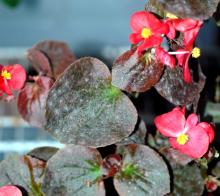Cause Erysiphe begoniicola (formerly Microsphaera begoniae), this fungus needs living tissue to grow and reproduce. It can be brought into a greenhouse on diseased plants. Temperatures of 70°F are optimal for colony development; however, temperatures >85°F are inhibitory to hyphal growth, sporulation and haustorial formation. More of a problem on Rieger begonia than wax begonia (B. semperflorens).
Symptoms Spots on leaves, stems, and flowers with a white powdery coating. In severe infections, reddish margins of dead tissue may surround the spots. The white fungus growth of the older spots frequently becomes brown. Some cultivars may develop only dark, bruised-looking areas without much fungal growth.
Cultural control
- Do not grow susceptible crop for several weeks. The fungus dies out and breaks the disease cycle.
- Start with healthy stock plants.
- Greenhouse temperatures at 86°F for 6 days can eradicate powdery mildew. Best if used during vegetative growth.
Chemical control Monitor crop carefully, and use sprays at first sign of the disease. Fungicides will do best when used before symptoms develop. Few materials have good eradicant activity Use at 7- to 14-day intervals; using shorter intervals when environmental conditions favor disease development. To reduce the possibility of resistant fungal strains, alternate or tank-mix fungicides from different groups that have a different mode of action.
When type II plant growth regulators (PGRs) are used for size control there can also be enhanced powdery mildew control when combined with fungicides. PGRs should not be used alone for powdery mildew control. Type II PGRs such as ancymidol (A-Rest), flurprimidol (Topflor) or paclobutrazol (Bonzi, Piccolo, etc.), however, can encourage resistance development to FRAC 3 fungicides.
- Armada 50 WDG at 3 to 9 oz/100 gal water. Do not use a silicone-based surfactant. Not for nursery or greenhouse use. Group 3 + 11 fungicide. 12-hr reentry.
- Avelyo at 3 to 5 fl oz/100 gal water. Group 3 fungicide. 12-hr reentry.
- Broadform at 2 to 4 fl oz/100 gal water. Group 7 + 11 fungicide. 12-hr reentry.
- Compass 50 WDG at 1 to 2 oz/100 gal water. Do not use organosilicate additives. Group 11 fungicide. 12-hr reentry.
- Disarm 480 SC at 1 to 4 fl oz/100 gal water. Group 11 fungicide. 12-hr reentry.
- Eagle 20 EW at 6 to 12 fl oz/100 gal water. Group 3 fungicide. 24-hr reentry.
- Fame SC at 1 to 4 fl oz/100 gal water. Group 11 fungicide. 12-hr reentry.
- Heritage at 1 to 4 oz/100 gal water plus a non-silicone-based wetter sticker. Group 11 fungicide. 4-hr reentry.
- Insignia SC at 3 to 6 fl oz/100 gal water. Do not use with organosilicate-based adjuvants. Use preventively only. Group 11 fungicide. 12-hr reentry.
- Myclobutanil 20 EW T&O at 6 to 12 fl oz/100 gal water plus spreading agent. May observe a PGR effect. Group 3 fungicide. 24-hr reentry.
- OHP 6672 4.5 F at 10 to 20 fl oz/100 gal water plus another fungicide. Group 1 fungicide. 12-hr reentry.
- Pageant at 6 to 12 oz/100 gal water. Do not use with organosilicone-based adjuvants. Group 7 + 11 fungicide. 12-hr reentry.
- Phyton 27 at 1.5 to 3 fl oz/10 gal water. Group M1 fungicide. 48-hr reentry.
- Pipron at 4 to 8 fl oz/100 gal water. Check for flower spotting if used after flower initiation. Greenhouse production only. Group 5 fungicide. 12-hr reentry.
- Regime at 20.5 to 45.7 fl oz/A. Group BM01 fungicide. 4-hr reentry.
- Safer Brand Garden Fungicide II (Ready To Use 0.4% sulfur) thoroughly sprayed over the entire plant. Do not use when the temperature is over 85°F or within a few weeks of an oil spray. H
- Seido at 4 to 5 fl oz/100 gal water plus an adjuvant. Group 50 fungicide. 4-hr reentry.
- Sil-Matrix at 1 to 4 quarts/100 gal water plus a nonionic surfactant. 4-hr reentry. O
- Spectracide Immunox Multi-Purpose Fungicide Spray Concentrate for Gardens at 1 fl oz/gal water. Group 3 fungicide. H
- Terraguard SC at 4 to 8 fl oz/100 gal water. Group 3 fungicide. 12-hr reentry.
- Trinity at 4 to 12 fl oz/100 gal water. Excessive rates may cause stunting. Group 3 fungicide. 12-hr reentry.
Biological control
- Cease or Rhapsody (Bacillus subtilis strain QST 713) at 2 to 8 quarts/100 gal water. Active ingredient is a small protein. Efficacy in the Pacific Northwest is unknown. 4-hr reentry. O
Reference Chase, A.R., Daughtrey, M.L., and Cloyd, R.A. 2018. Compendium of Bedding Plant Diseases and Pests. St. Paul, MN: APS Press.


